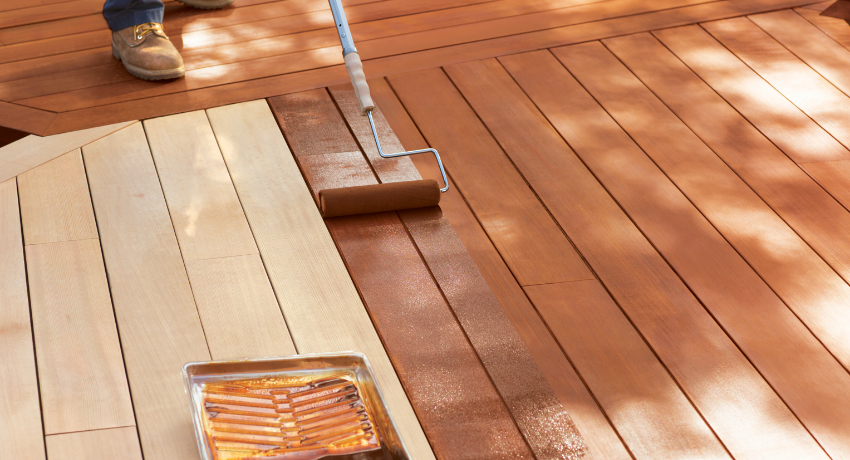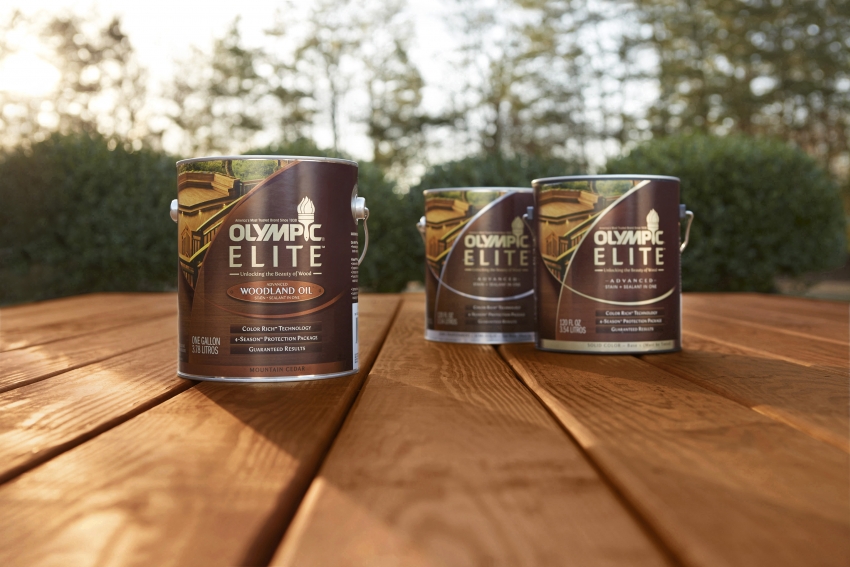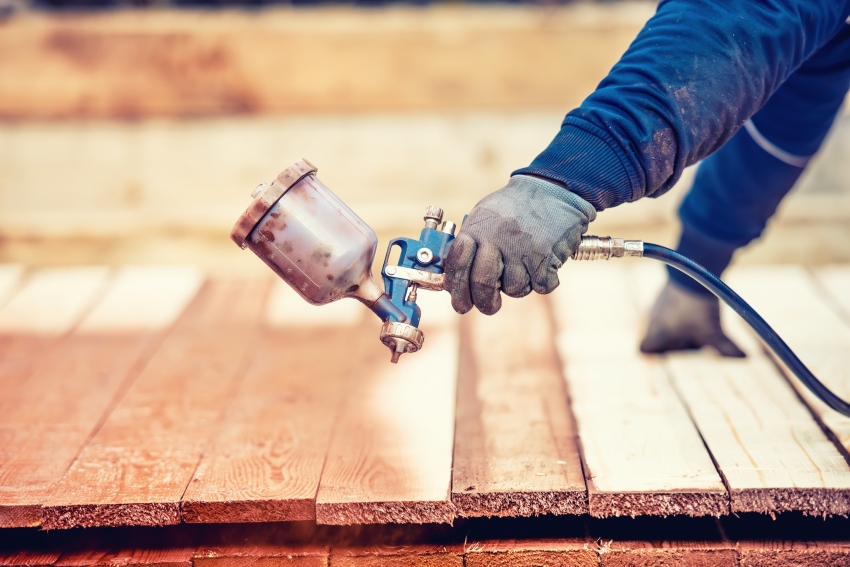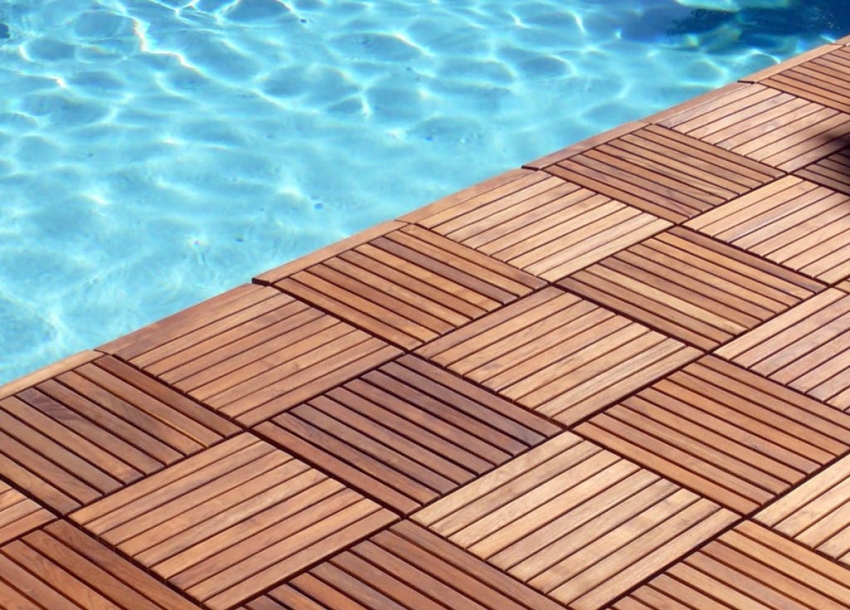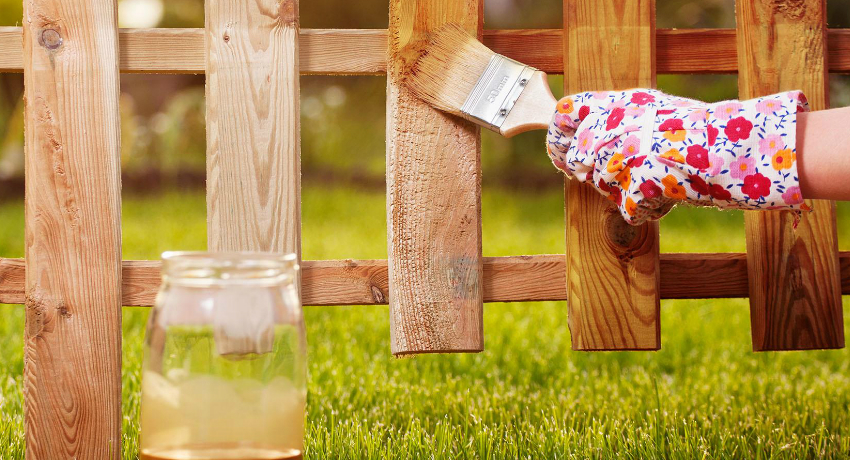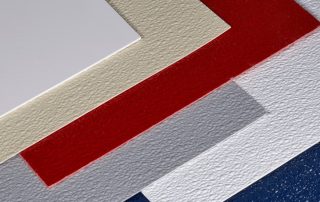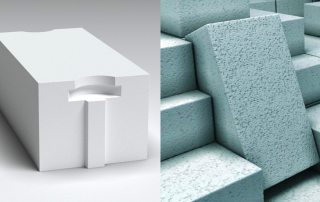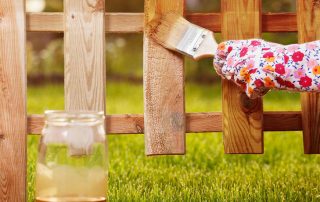This article discusses such a popular type of finishing material as wood paint for outdoor use. In the text, you can find an overview of the main categories of dyes used to decorate and protect facades made of wood and other objects used in outdoor conditions. Consider the properties and characteristics of alkyd, acrylic, oil and water-based compositions, as well as a description of popular brands.
Content [Hide]
Wood paint for outdoor use and its types
Wood as a building material has many benefits. It is budgetary, affordable, environmentally friendly and easily lends itself to various types of processing. Although this material has disadvantages, the most significant of them is its vulnerability to atmospheric phenomena. Therefore, dyes are used as finishing not only for decorating wooden elements, but also for their protection.
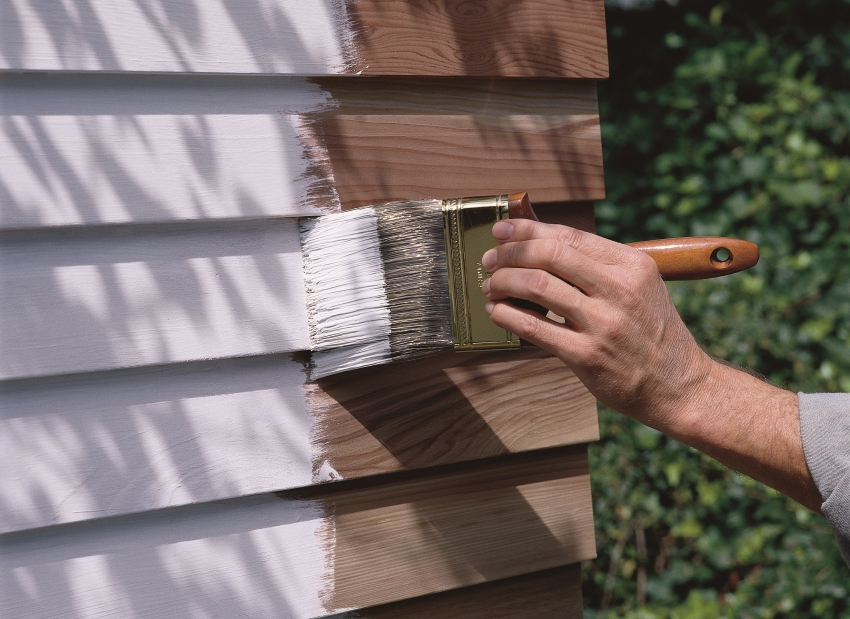
Acrylic exterior paint creates a durable, dense coating that protects wood from negative external factors
If the dye is selected correctly, the service life of the building material increases.
and provides protection against the effects of moisture, biological pests and ultraviolet rays, which have a detrimental effect on wood.
The modern market allows consumers to buy wood fence paints of the following types:
- latex compounds;
- acrylic-based mixtures;
- dyes with added oils;
- alkyd compounds;
- water-based facade paints.
Almost all paint and varnish compositions have similar parameters, which are due to the common function of these materials - to protect the wooden surface. The differences lie only in the composition and some properties, as well as the decorative effect.
Helpful advice! Before purchasing a dye, it is recommended that you first familiarize yourself with the information offered by the manufacturer, which reveals the properties of the product, its technical and operational characteristics, capabilities, features and composition.
Properties of latex paints for exterior woodwork
Latex or silicone dyes are not in high demand due to their high cost. The properties of this coating are useful for finishing objects used in humid climates. The main component of such formulations are silicone resins.
Latex-based wood stains have the following features:
- high strength characteristics of the coating, providing protection even with a single layer of application;
- resistance to the aggressive influence of reagents (to clean the surface opened with latex dye, you can use not only water, but also alkaline solutions, without fear that the coating will become stained, damaged or lose color brightness);
- inertness in relation to ultraviolet radiation (thanks to this parameter, the coating does not fade for a long time and does not need to be updated frequently).
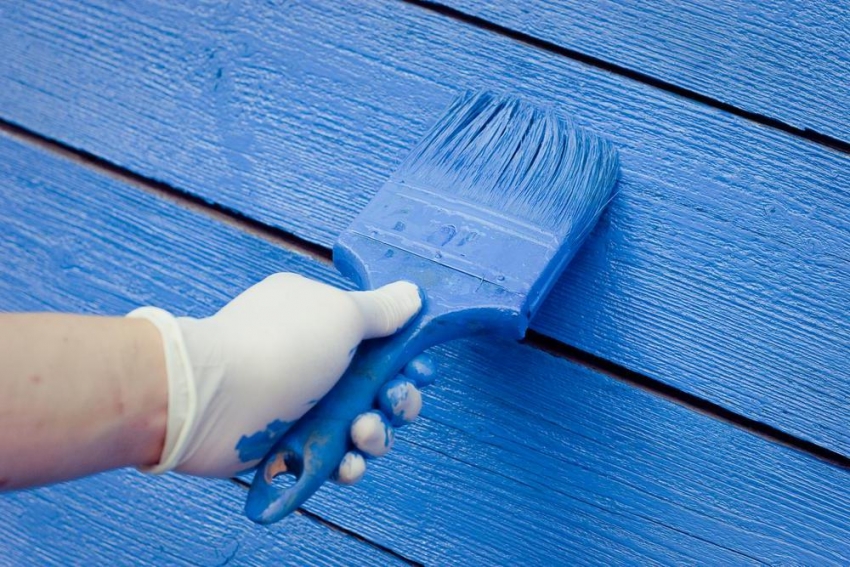
Latex paints for wood have a high degree of strength, which allows you to protect the coating even with one-layer painting
Latex dyes are characterized by increased resistance to moisture. The material reacts well to mechanical stress in the form of friction and retains its integrity for a long time. Unlike their counterparts, in the form of acrylic paints for wood for outdoor use, silicone-based compounds are less vulnerable to high temperatures and offer a higher vapor permeability. Silicone compounds can be applied over other paints and varnishes.
Properties of oil dyes for facade finishing
Oil dyes are characterized by low cost. Most often, the main component of the composition is drying oil, which is an environmentally friendly substance.
To make drying oil, pressed oil from the following plants is used:
- sunflowers;
- hemp;
- flax.
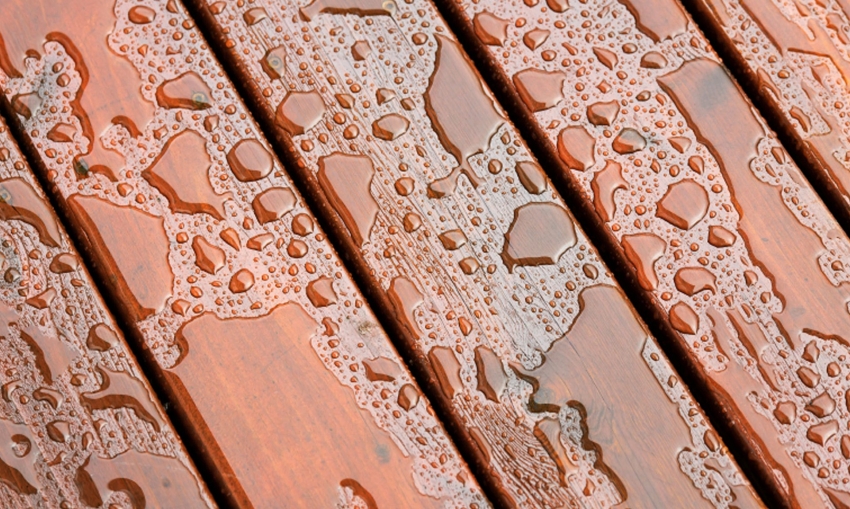
One of the advantages of oil colors for the facade is a high degree of hydrophobicity, which allows you to permanently protect the wood finish
Apart from being environmentally friendly, this paint does not have many advantages, so it is not as popular as other types of coatings.
Disadvantages of oil based dyes:
- a pungent unpleasant odor that persists throughout the drying time;
- the coating quickly fades in direct sunlight;
- dries for a relatively long time (minimum - 12 hours);
- short service life - 3 years;
- low vapor permeability.
Important! It is strictly forbidden to apply oil formulations over water-based paint for outdoor work. This will require preliminary removal of the old paint layer.
Properties of acrylic facade paints for outdoor use
Acrylic paints are the most widespread and popular group of compounds used for finishing the facades of buildings and other objects.
Properties of acrylic-based dyes:
- the composition forms a protective film on the treated surface;
- the finishing has a high degree of protection against seasonal influences and atmospheric factors;
- high wear resistance;
- the surface has good vapor permeability;
- the coating dries quickly;
- the composition does not have an unpleasant odor;
- the finish is characterized by high adhesion;
- the compositions can be independently tinted in any shades.
- long service life - up to 20 years.
Consumers can buy two types of acrylic paint for wood:
- Water-dispersed.
- Solvent based.
Solvent-based acrylic facade paints have other additives. These mixtures contain weather-resistant substances, UV filters and an organic resin. All of these components ensure long-term absence of cracks, burnout and moisture damage. Moreover, the coating has a breathable surface. In addition, the material is protected from the negative effects of temperature extremes.
Several brands offer solvent-based acrylics with special properties.For example, Akrial-Lux can be applied to wood even at low temperatures. Coloring is allowed when outdoors up to -20 ° C.
Water-dispersed dyes consist of fillers and polymers. In some cases, there are compositions with the addition in the form of marble chips.
Properties of outdoor alkyd wood paints
Alkyd dyes are based on resins. As an addition, oils are also present in the composition. The advantage of these materials is fast drying. Thanks to this, dust and debris will not have time to adhere to freshly painted wood, and sudden rainfall will not spoil the result.
Alkyd compositions are inherent in moisture repellent properties. Treated wood receives full protection from liquids, so these dyes are recommended for finishing buildings in regions with high humidity. The same applies to buildings located near open bodies of water. The consumption of facade paint per 1 m2 is 100-120 g.
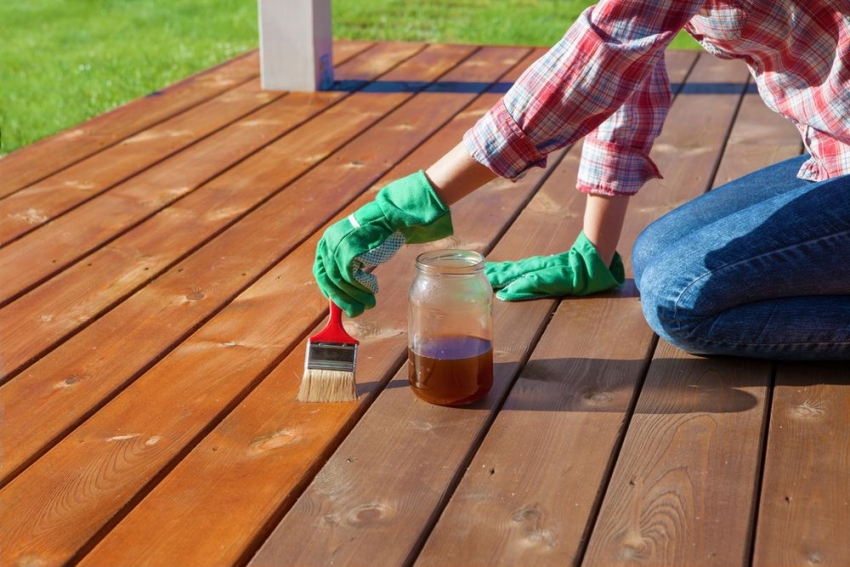
Thanks to resins and oils in the composition of alkyd dyes, the coating has a high degree of vapor permeability, which is important for buildings located near water bodies or in places with high humidity
This type of composition is not able to penetrate the structure of the material, the presence of paint is only superficial. Therefore, it cannot be said that the tree is fully protected from any impact. During the dyeing process, a strong membrane-like film is formed on the surface. But she absolutely does not let the air through. Moreover, manufacturers omit this point.
Important! Alkyd based paint should not be applied to damp wood. The material should be thoroughly dried before processing. Otherwise, the surface of the coating will be covered with bubbles, after which it will begin to flake and peel off ahead of time.
Alkyd paints are in many ways inferior to acrylic compositions. The glossy shine on the coating does not last long. Gradually, a matte effect appears on the surface. Under the influence of ultraviolet light, a rather rapid shade fading occurs. The service life is also short.
Advantages and disadvantages of water-based wood paints for outdoor use
Water-based dyes are commercially available as acrylic, silicate, silicone-type compositions, as well as mineral emulsion mixtures. Therefore, the price of facade water-based paint for outdoor use varies in a wide range - from 400 to 5000 rubles.
Advantages of water-based finishing materials:
- high throughput;
- absence of toxic substances in the composition;
- large palette of shades;
- the most primitive tools are suitable for staining;
- painted surfaces are not afraid of chemicals used for cleaning, so you can easily cope with removing stains;
- if the dye gets on the skin or other objects, it can be removed with water and soap;
- the coating is elastic and not prone to cracks;
- long service life.
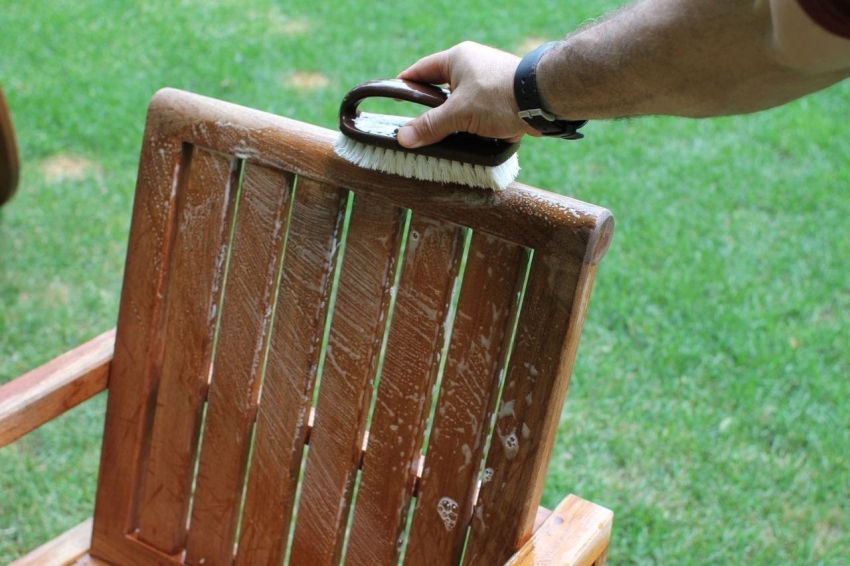
Items painted with water-based paint for wood for outdoor use, can be cleaned with detergents
There are not many disadvantages. First, the coating is more vulnerable to moisture than other formulations. Secondly, dyes contain water, so the wood can swell after processing. To avoid this, it is recommended to additionally use protective equipment. Therefore, the question of whether it is possible to paint a tree with water-based paint without preliminary treatment disappears.
Related article:
Which paint for wood for outdoor use is better: the main types of compositions
The main types of compositions used for decoration. Features of dyes, their characteristics and properties, the choice of the best.
Characteristics and features of dyes of popular brands
For the staining result to be of high quality, the wood surface must be dry and clean. Care should be taken to keep the material free from dirt and grease. Preliminary preparation designed to improve the quality of painting work includes the application of a primer or oil. For these purposes, a mixture consisting of stain and putty is also suitable.

In order to obtain a durable and reliable coating of a wooden surface, it is worth using dyes from well-known brands.
Preliminary surface preparation will allow:
- patch up all cracks and pores on the base;
- increase resistance to mechanical properties;
- improve the decorative qualities of the coating.
Helpful advice! Treating the surface with an antiseptic will eliminate the likelihood of mold and fungal spores in the wood.
An important condition for obtaining a high-quality and durable coating is also a detailed acquaintance with the manufacturer's recommendations regarding layer thickness, application technology and drying time.
Features of Tikkurila facade paints, the price of compositions
Among Finnish paints for wood for outdoor use, Tikkurila's products occupy one of the leading positions. The most demanded compositions of this manufacturer are silicone-based materials.
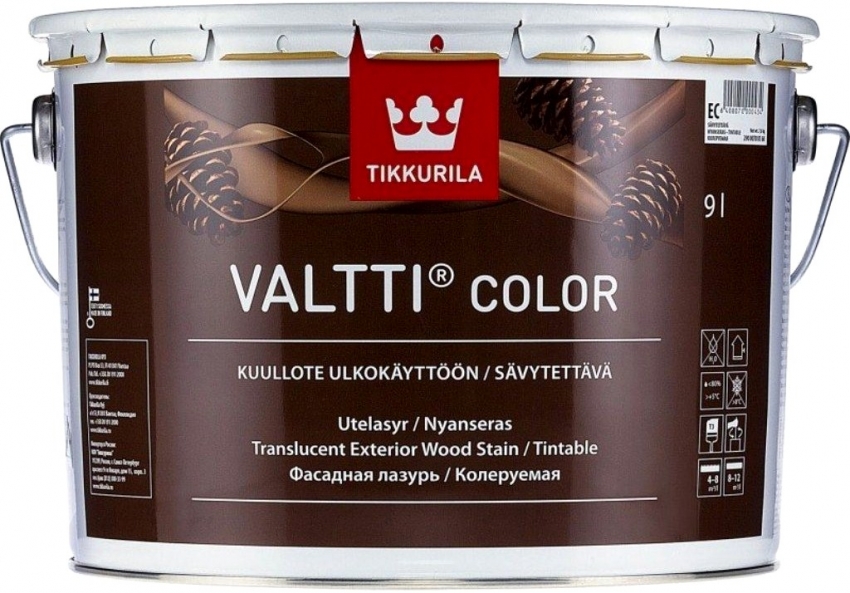
When used correctly, dyes from Tikkurila can have a glossy, matte, satin and even pearlescent sheen.
These dyes have many benefits:
- absolute safety for the environment and human health;
- due to environmental friendliness, the compositions do not cause allergic reactions, therefore, they can be used for decorating children's institutions (street structures);
- high vapor permeability preventing moisture accumulation;
- long service life;
- lack of reaction to ultraviolet light, the pigment retains brightness and saturation for a very long time;
- invulnerability to mechanical stress.
The coating is endowed with self-cleaning ability. During precipitation, the liquid washes away dirt from the surface. Consumption of the dye in a single layer is 1 liter per 14 m². The average price of a dye is 5,000 rubles. for a container with a volume of 10 liters.
Properties and specificity of Caparol facade paint, the price of compositions
Despite the high cost (about 4500 rubles per 5 liters), Caparol dyes are widely known and are in great demand on the market. The products offer consumers a number of beneficial advantages that fully justify the high price of the formulations.
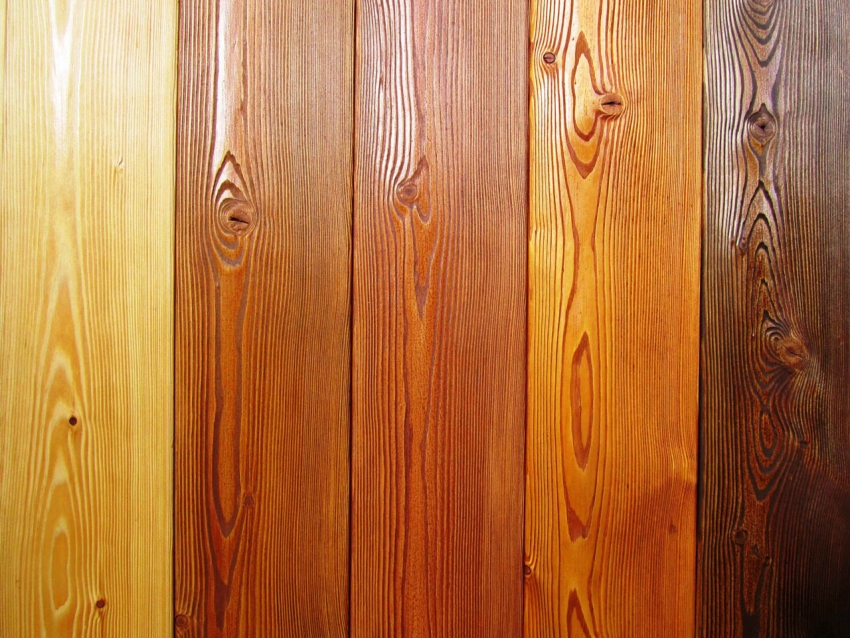
The market leader of building paints Caparol offers customers a wide selection of paints and varnishes for wood, which differ in a wide range of colors and high quality coating
All facade types of finishing materials are environmentally friendly. For this reason, you do not have to worry about the negative impact on people, animals or the environment. The products are marked with a "Blue Angel", which confirms the successful passage of the inspection through the system of the agency responsible for environmental control. Water-thinnable glazes are most often used for wood processing.
Azure is suitable for finishing the following objects:
- window and door structures;
- upholstery with veneer or tongue;
- gates and shutters;
- frame structures;
- sheathing boards;
- railings and railings on balconies;
- formwork structures;
- pergolas and shingle roofs;
- panelboard parts, the material for the manufacture of which was plywood or timber.
Interesting fact! Common enamels with similar properties contain about 50% solvents. Dispersion compositions for Caparol facades most often do not contain such substances or their amount does not exceed 2%.
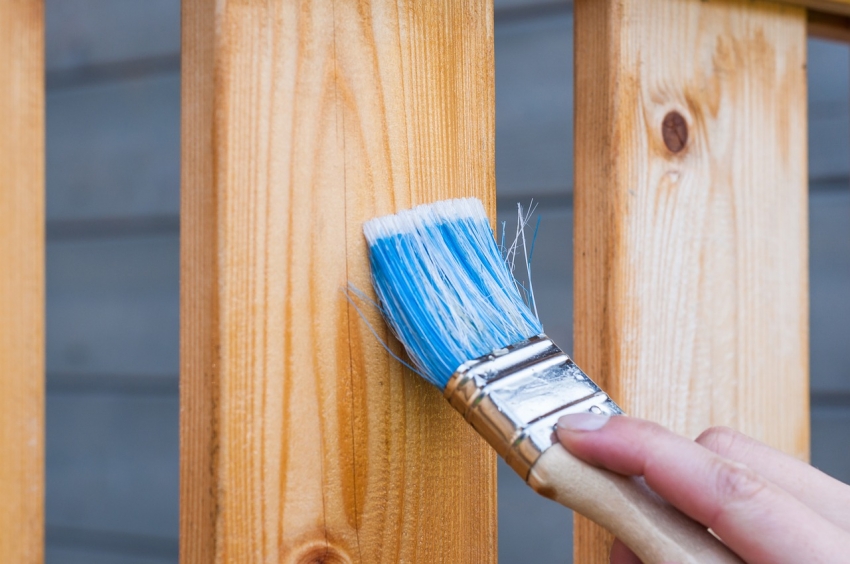
Some types of compounds protect the structure by penetrating into the material and are almost colorless, which allows not to hide the structure and color of natural wood under the paint
Properties of Caparol dyes:
- resistance to wind loads and precipitation;
- the ability to maintain their qualities even under the influence of ultraviolet radiation;
- reliable protection of wood from the influence of moisture;
- high throughput.
Technical characteristics of perchlorovinyl facade paint ХВ-161
Perchlorovinyl compounds are characterized by the saturation and brightness of colors, relatively short drying time, excellent adhesive properties, which made them so popular.
Perchlorovinyl facade paint XB-161 is saturated with plasticizers. Thanks to these components, most of the positive qualities are provided and the scope of application of the finish is expanding. This type of dye can be classified as a universal material. The operating temperature range is from -20 to + 40 ° С. The coating is a mixture of colored pigments. These particles are supplemented with fillers and dissolved in the PVC varnish composition.
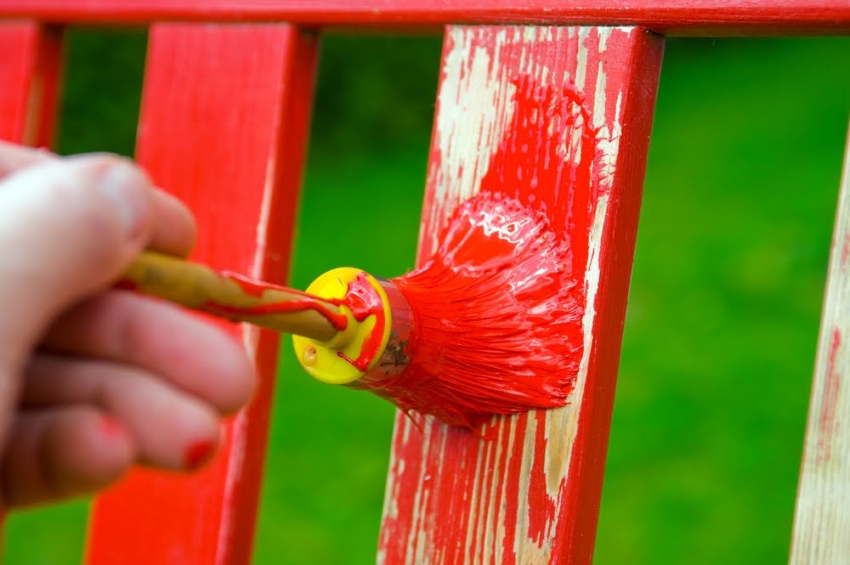
Perchlorovinyl paint is used for finishing external structures and buildings, forming a dense protective and decorative layer on the surface
Average consumption of the dye in a single coat is 180-220 g / m². However, a double coat is required for quality staining. The material is ideal for processing objects that are under the influence of an aggressive environment. ХВ-161 can be used as wood-like paint for doors.
Before painting, it is recommended to thoroughly prepare the surface: plaster and level, make sure there are no cracks or chips, clean the base and dry it. Vinyl perchloride compounds should not be applied to the substrate over the following types of coatings:
- acrylic;
- calcareous;
- organosilicon;
- silicate.
All these materials must be removed from the surface before proceeding with painting it with XB-161. The average price of the dye is 120 rubles / kg.
Features of the facade textured paint VD-AK-1180 VGT
Dye VD-AK-1180 is an acrylic-based composition with a matte coating surface. The material has a high covering ability and excellent adhesive properties. The coloring results in an air-permeable coating that is UV-resistant and not prone to yellowing. The composition contains apple flavor.

The surface covered with VD-AK-1180 paint has a beautiful matte color and does not fade when exposed to direct sunlight
VD-AK-1180 can be used not only for outdoor work, but also as a decoration for indoor spaces where there is no heating. The dye has a whiteness level of 90%. Tinting in any desired color is possible. It is recommended to degrease the surface before painting. Application can be done with a roller, brush or spray. Dilution with water in an amount not exceeding 10% of the total volume is allowed.
Price of paints for wood fence VD-AK-1180:
| Packing, kg | price, rub. |
| 1,5 | 115 |
| 3 | 235 |
| 7 | 495 |
| 15 | 1015 |
The list of demanded dyes for the protective treatment of wooden surfaces does not end there. There is a wide selection of manufacturers and a significant variety of species on the market, allowing you to choose a finishing material for any customer needs and surface requirements.
